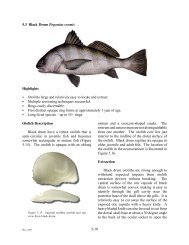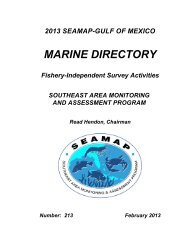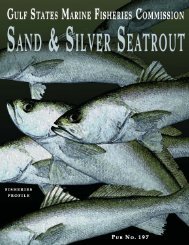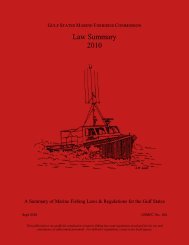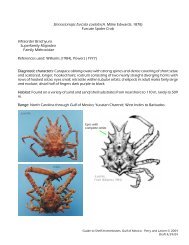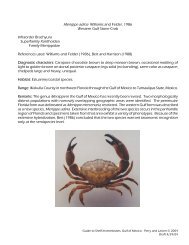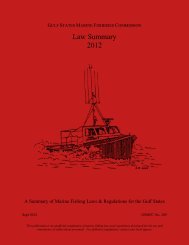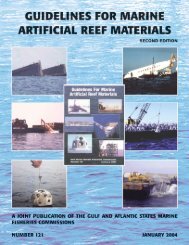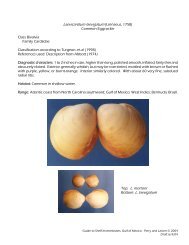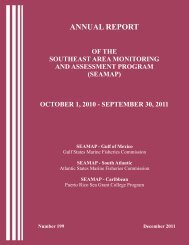Basic Commercial Fishing Regulations - Gulf States Marine ...
Basic Commercial Fishing Regulations - Gulf States Marine ...
Basic Commercial Fishing Regulations - Gulf States Marine ...
You also want an ePaper? Increase the reach of your titles
YUMPU automatically turns print PDFs into web optimized ePapers that Google loves.
Live bait dealers must mark their boats with the words “LIVE BAIT” in letters no smaller than six inches (6”) high on both<br />
the port and starboard sides of the boat. The name of the bait camp must be similarly displayed on the boat and transport<br />
vehicle. Fish caught coincidental to the live bait operation may be retained and sold for chum; however, if crabs are to be<br />
kept, the dealer is also required to hold a valid Mississippi crab license. Fish retained must be of legal size. Live bait camps<br />
must meet the following special requirements.<br />
Each camp must have adequate holding and aerating systems which must be cleaned of dead shrimp at least every twelve<br />
hours (12 hrs). No bulk sales of dead shrimp are permitted; dead shrimp may be sold only with heads on and in sixteenounce<br />
(16 oz) containers. No more than five 16 oz containers may be sold to an individual in one day. Someone must be<br />
readily available to serve customers during appropriate hours, and each live bait dealer application must include these hours,<br />
which must be at least eight per twenty-four hour period.<br />
Fish Retained for Consumption<br />
Licensed vessels may keep in whole, for personal consumption only, the following types of fish which are caught in the<br />
shrimp nets or trawls of the vessel: white trout, croaker, black drum, ground mullet, sheepshead, gaftopsail catfish, and<br />
flounder. The cumulative total of fish shall not exceed twenty-five pounds (25 lbs). In addition, a vessel may keep threedozen<br />
(36) blue crabs. This exemption for personal consumption does not apply to fish or crabs that are otherwise illegal to<br />
possess or catch.<br />
SHELLFISH – OYSTERS AND CLAMS<br />
License Requirements<br />
Each vessel used to catch, take, carry, or transport oysters from the reefs of the state of Mississippi, or engaged in<br />
transporting any oysters in any of the waters within the territorial jurisdiction of the state of Mississippi, for commercial use,<br />
shall annually, before beginning operations, be licensed by the MCMR and pay the following license fees:<br />
Tonging<br />
Resident - $50.00<br />
Nonresident - $100.00<br />
Dredging<br />
Resident - $100.00<br />
Nonresident - $200.00<br />
Each person catching or taking oysters from the waters of the state of Mississippi for personal use shall obtain a permit from<br />
the MCMR and pay an annual recreational oyster permit fee of ten dollars ($10.00). Oysters caught under a recreational<br />
permit shall not be offered for sale. The limit on allowable catch of oysters for recreational purposes shall be three (3) sacks<br />
per week. The MDMR shall issue tags of a distinguishing color to designate recreationally harvested oysters, which shall be<br />
tagged on the same day of harvest in the manner prescribed below.<br />
Season<br />
Season is regulated by legal notice from the MCMR, and notice thereof will be duly published in local newspapers and<br />
released to both radio and television media. During open season, oysters may be taken only during daylight hours.<br />
Gear<br />
Oysters may be taken by any of the traditional methods of oystering in the state of Mississippi, that is, by hands (cooning),<br />
with tongs, or by using a dredge. Dredges for oystering may not exceed one hundred forty pounds (140 lbs) in weight nor<br />
may they have in excess of sixteen (16) teeth. Teeth on the dredge must be five inches (5”) or less. Restrictions on the<br />
maximum number of dredges carried will be established by the MCMR.<br />
It is unlawful for any person to catch or take oysters by means of dredging in any of the waters designated as tonging reefs by<br />
the MCMR.<br />
The MCMR shall designate certain areas as tonging reefs. The MCMR shall mark the boundaries of the areas designated by<br />
appropriate poles, stakes, or buoys of material that will not injure watercraft. The MCMR may authorize the taking of<br />
oysters on reefs designated as tonging reefs by dredge, drag, or scoop if the MCMR finds that the dredging, dragging, or<br />
scooping is necessary to manage the resource properly. Any dredging, dragging, or scooping authorized under this section<br />
shall be for a specific time period as provided by the MCMR.<br />
139




